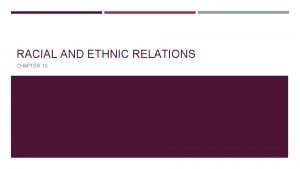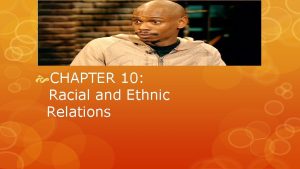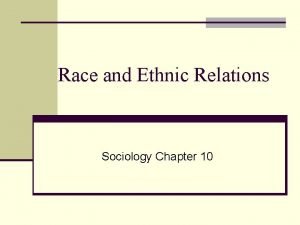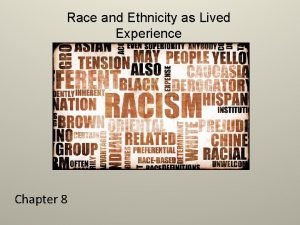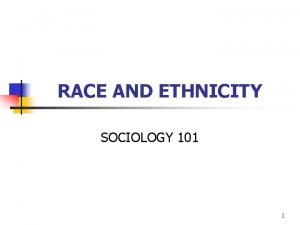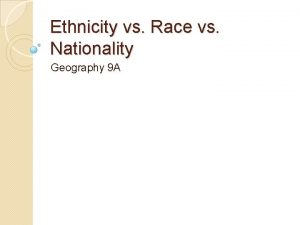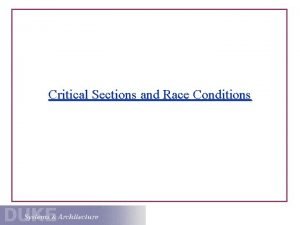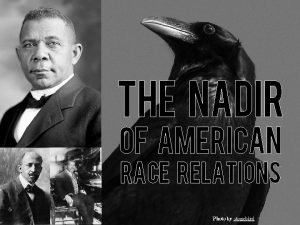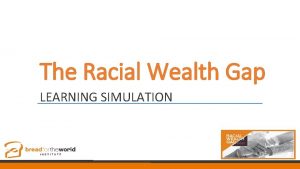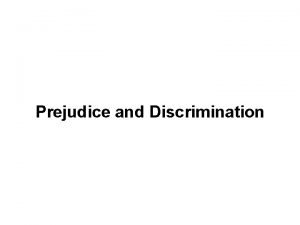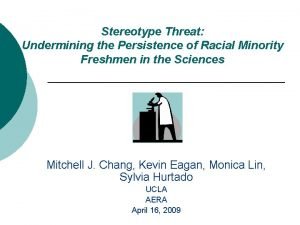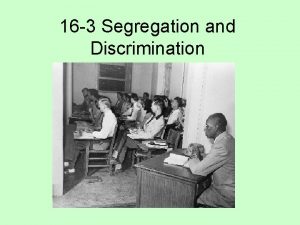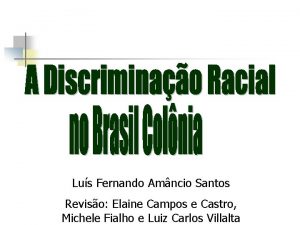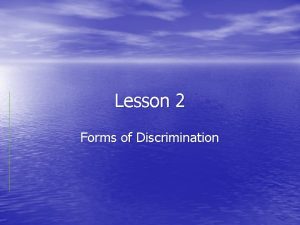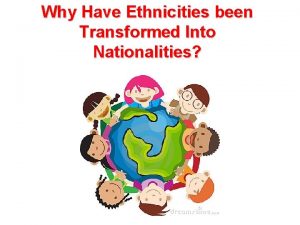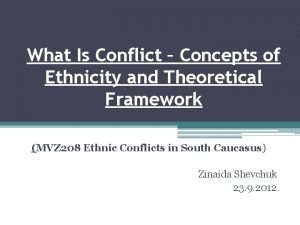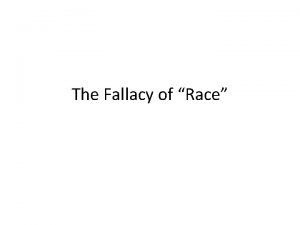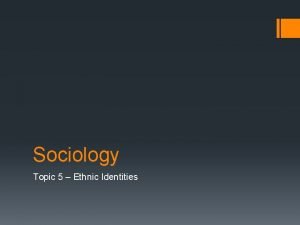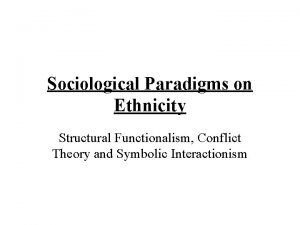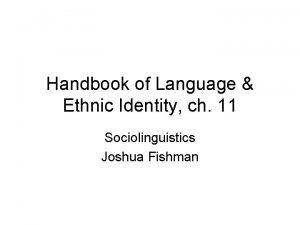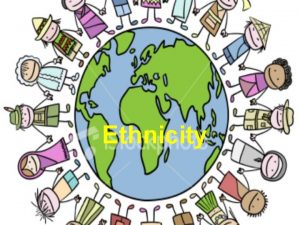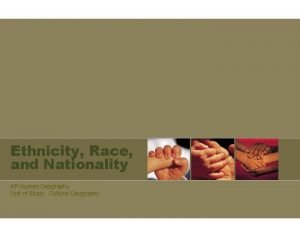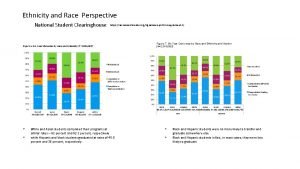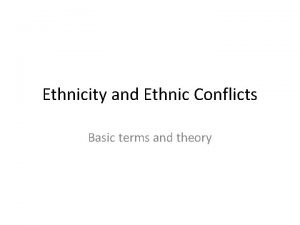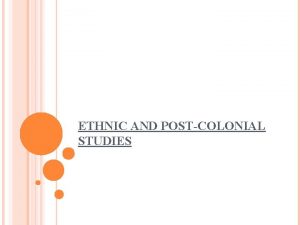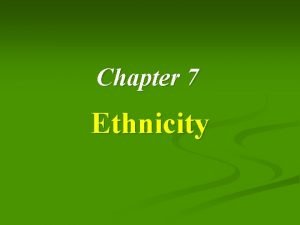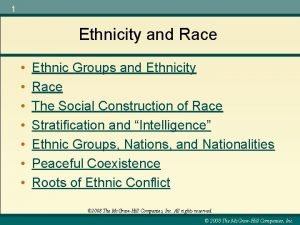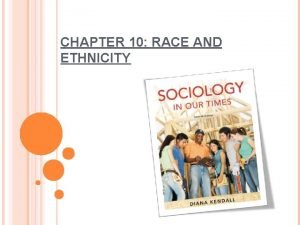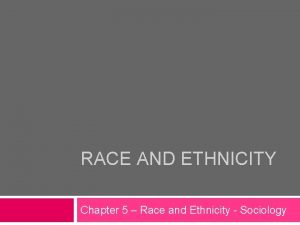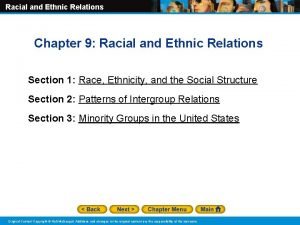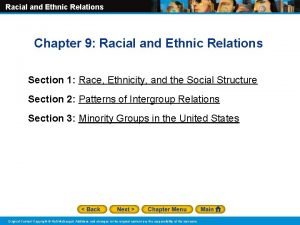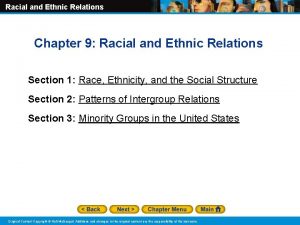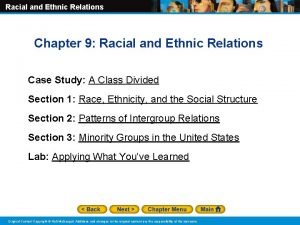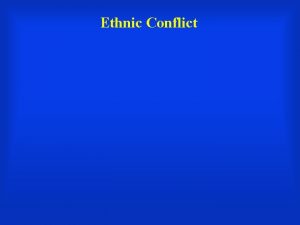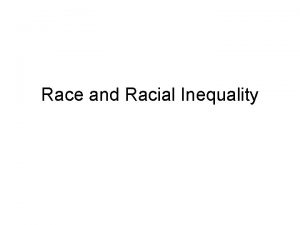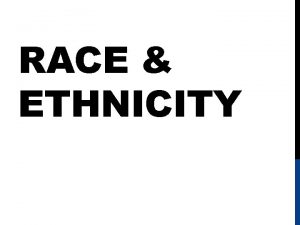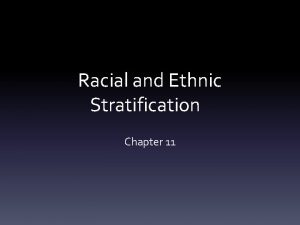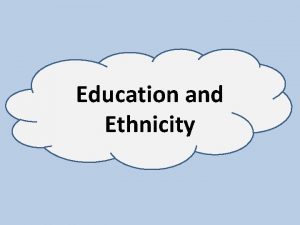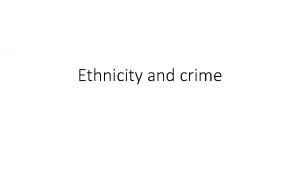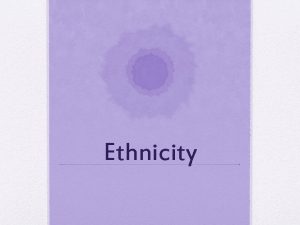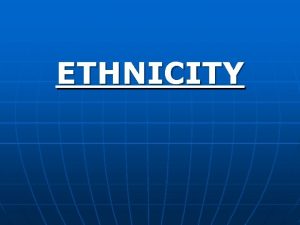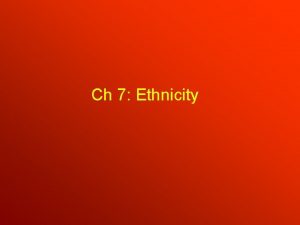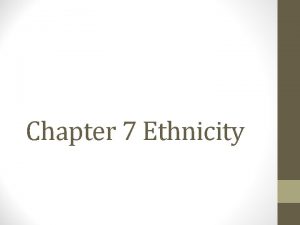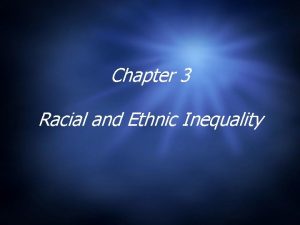RACIAL AND ETHNIC RELATIONS CHAPTER 10 RACE ETHNICITY



































- Slides: 35

RACIAL AND ETHNIC RELATIONS CHAPTER 10

RACE, ETHNICITY, AND SOCIAL STRUCTURE Race – a category of people who share inherited physical characteristics and who others see as being a distinct group.

RACE, ETHNICITY, AND SOCIAL STRUCTURE One of the best known classification systems sort people into three racial groups: Caucasoids: fair skin, straight or wavy hair Mongoloids: yellowish or brownish skin, distinct folds on the eyelids Negroids: dark skin, woolly hair This classification system is no longer used because there are no biologically “pure” races.

RACE, ETHNICITY, AND SOCIAL STRUCTURE Ethnicity- the set of cultural characteristics that distinguishes one group from another. Ethnic Groups tend to share cultural characteristics such as national origin, language, religion, customs, and values

RACE, ETHNICITY, AND SOCIAL STRUCTURE Minority Group – a group who are singled out and treated unequally due to their physical characteristics or cultural practices

RACE, ETHNICITY, AND SOCIAL STRUCTURE Characteristics of Minority Groups: Identifiable physical or cultural physical cultural characteristics Victims of unequal treatment Group membership is an ascribed status Members share strong bonds and a sense of loyalty Members tend to practice endogamy or marriage within their own groups

PATTERNS OF INTERGROUP RELATIONS Discrimination vs Prejudice Discrimination denial of equal treatment based on group membership; involves behaviors Prejudice – unsupported generalization about a category of people, involves attitudes and can be positive

PATTERNS OF INTERGROUP RELATIONS Discrimination Legal Discrimination is upheld by the law Examples: Apartheid of South Africa Women not having the right to vote Jim Crow laws

PATTERNS OF INTERGROUP RELATIONS Institutionalized Discrimination is an outgrowth of society Examples: Denied access to jobs/housing Concentration in low-income communities This is where the cycle of inequality is maintained

PATTERNS OF INTERGROUP RELATIONS Prejudice Negative forms of prejudice often include stereotypes or oversimplified, exaggerated, or unfavorable generalization about a group of people.

PATTERNS OF INTERGROUP RELATIONS

PATTERNS OF INTERGROUP RELATIONS Stereotyping can have very negative consequences. If people are told often enough and long enough that they or others are socially, mentally, or physically inferior they may come to believe it. Self-fulfilling prophecy is a prediction that results in behavior that makes the prediction come true.

PATTERNS OF INTERGROUP RELATIONS Racism is the belief that one’s own race or ethnic group is naturally superior to other races or ethnic groups. Racism has been used to justify atrocities such as slavery and genocide

PATTERNS OF INTERGROUP RELATIONS The active bigot is prejudiced and openly discriminatory. The timid bigot is prejudiced, but is afraid to discriminate due to social pressures. The fair-weathered liberal is not prejudice, but discriminates anyways because of social pressures. The all-weather liberal is not prejudice and does not discriminate.

PATTERNS OF INTERGROUP RELATIONS

PATTERNS OF INTERGROUP RELATIONS Sources of Prejudice and Discrimination Sociological Explanations The social environments Accepted societal norms Internalization of norms People often become prejudiced to maintain their group membership. They may also become prejudiced through identification with a reference group that encourages and supports such behavior.

PATTERNS OF INTERGROUP RELATIONS Sources of Prejudice and Discrimination Psychological Explanations People may be prejudiced because of their personality type (Authoritarian Personality). People may be prejudiced due to frustration and anger. They may blame others for their troubles – this is called scapegoating

PATTERNS OF INTERGROUP RELATIONS Minority groups are often scapegoats for a variety of reasons such as: They are easy to recognize (physical features, language, ect) They lack power in society They are often concentrated in geographic areas They have been targets of scapegoating in the past They represent something such as an idea, attitude, or way of life the scapegoater does not like.

PATTERNS OF INTERGROUP RELATIONS Patterns of Minority Group Treatment Cultural Pluralism Assimilation Legal Protection Segregation Subjugation Population Transfer Extermination

PATTERNS OF INTERGROUP RELATIONS Cultural Pluralism allows each group within society to keep its unique cultural identity. Switzerland is an example of this: Three official languages – one for each of the major ethnic groups French German Italian

PATTERNS OF INTERGROUP RELATIONS Assimilation occurs when distinct cultural groups blend into a single group with a common feature and identity. The image of America is the “melting pot” Some assimilation occurs voluntarily and sometimes it is forced. Bulgaria forbid the Turks from practicing their religion, using their language, and from celebrating their culture.

PATTERNS OF INTERGROUP RELATIONS Legal Protection ensures the rights of minority groups are protected. Examples: The Civil Rights Act of 1964 and the Voting Rights Act of 1965 Affirmative Action programs in the US Reverse discrimination can occur when preference is given to women and minorities.

PATTERNS OF INTERGROUP RELATIONS Segregation refers to policies that physically separate a minority group from the dominant group. De jure segregation is based on law Jews forced to live in ghettos De facto segregation is based on informal norms Minorities concentrated in cities

PATTERNS OF INTERGROUP RELATIONS Subjugation is the maintaining control over a minority group through force. Slavery is the most extreme form of subjugation Apartheid in South Africa was the legal segregation of groups. This practiced lasted until the 1990’s.

PATTERNS OF INTERGROUP RELATIONS Population transfer is when the dominant group in society separates itself from the minority group by transferring the minority population to a new territory. Example: The forcible removal of Native Americans from their lands onto reservations.

PATTERNS OF INTERGROUP RELATIONS Extermination is the most extreme response to the existence of minority groups within a country. Genocide is the intentional destruction of an entire targeted population. Anti-Semitism Rwandan Genocide

PATTERNS OF INTERGROUP RELATIONS Ethnic cleansing is the combination of population transfer and extermination. The practice is done by removing a group using terror, expulsion, and mass murder. The Serbian government sought to drive out and kill Albanians from Kosovo

MINORITY GROUPS IN THE UNITED STATES Although Americans express support for equality, freedom, dignity of the individual, and inalienable rights, they have not always lived up to these ideals. Enslavement and segregation of African Americans Internment of Japanese Americans in WWII Many people think of the typical American as a WASP (White Anglo-Saxon Protestant) Minorities tend to be successful if they adapt to the WASP image.

MINORITY GROUPS IN THE UNITED STATES African Americans 13. 2% of Americans identify as African American That’s about 6. 8 million people The Civil Rights Movement brought significant gains for African Americans

MINORITY GROUPS IN THE UNITED STATES Hispanics 17. 4% of Americans identify as Hispanic That is 8. 6 million people Many enter through legal means while others arrive illegally for political freedom and economic opportunities


MINORITY GROUPS IN THE UNITED STATES Asian Americans 5. 4 % of Americans identify as Asian That’s about 2. 2 million people Chinese Exclusion Act Japanese Interment Considered the “model minority”

MINORITY GROUPS IN THE UNITED STATES Native Americans Approximately 50% of Native Americans on or near reservations are unemployed 31% of all Native Americans live below poverty The rate of alcohol related deaths is 7 times higher than the general population. Only about 66% of Native Americans over 25 graduated from high school and only 10% graduate from college.

MINORITY GROUPS IN THE UNITED STATES Native Americans were forced to assimilate to white society. Many were taken from their parents and put into boarding schools to break ties with their culture Those who lived off reservations and adopted white culture were given citizenship – 1/3 did not have citizenship until 1924. Indian Citizenship Act of 1924

MINORITY GROUPS IN THE UNITED STATES White Ethnics This group tended to be from Ireland, Italy, France, Poland, and Greece in the late 1800 s and early 1900 s. They were often Catholic and did not speak English Most white ethnics have assimilated to white society to avoid discrimination.
 Timid bigot example
Timid bigot example Chapter 10 racial and ethnic relations
Chapter 10 racial and ethnic relations Chapter 10 racial and ethnic relations review worksheet
Chapter 10 racial and ethnic relations review worksheet Chapter 8: race and ethnicity as lived experience
Chapter 8: race and ethnicity as lived experience Definition of race and ethnicity
Definition of race and ethnicity Race vs ethnicity vs nationality
Race vs ethnicity vs nationality Reaction and impulse turbine difference
Reaction and impulse turbine difference Forebay design
Forebay design Data race vs race condition
Data race vs race condition Nadir of race relations
Nadir of race relations Black studies and the racial mountain
Black studies and the racial mountain Employee relations in public relations
Employee relations in public relations Jim crow laws in what region or regions did it exist
Jim crow laws in what region or regions did it exist Racial wealth gap simulation
Racial wealth gap simulation Promoting racial literacy in schools
Promoting racial literacy in schools Racial theories apush
Racial theories apush Racial prejudice
Racial prejudice Don tibursio
Don tibursio Racial insults
Racial insults Chapter 16 section 3 segregation and discrimination
Chapter 16 section 3 segregation and discrimination Cartel ley organica contra la discriminacion racial
Cartel ley organica contra la discriminacion racial Democracia racial
Democracia racial Lesson 2 discrimination
Lesson 2 discrimination Countries and nationalities
Countries and nationalities Concept of conflict
Concept of conflict Troian bellisario ethnicity
Troian bellisario ethnicity What is ethnicity
What is ethnicity Symbolic interactionism vs functionalism
Symbolic interactionism vs functionalism Symbolic ethnicity
Symbolic ethnicity Ethnicity in sociolinguistics
Ethnicity in sociolinguistics Lactose intolerance by ethnicity
Lactose intolerance by ethnicity Elements of nationalism include all but
Elements of nationalism include all but Ethnicity examples
Ethnicity examples What is ethnicity
What is ethnicity Ethnic studies and postcolonial criticism
Ethnic studies and postcolonial criticism Multinational state
Multinational state
